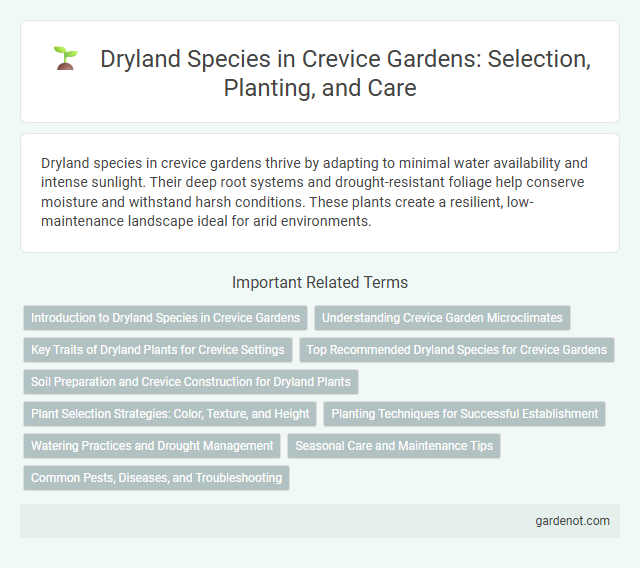Dryland species in crevice gardens thrive by adapting to minimal water availability and intense sunlight. Their deep root systems and drought-resistant foliage help conserve moisture and withstand harsh conditions. These plants create a resilient, low-maintenance landscape ideal for arid environments.
Introduction to Dryland Species in Crevice Gardens
Dryland species in crevice gardens thrive due to their exceptional drought tolerance and ability to survive in nutrient-poor, well-drained soils. These plants, including succulents, drought-resistant perennials, and alpine species, adapt by storing water in leaves or roots and minimizing transpiration. Crevice gardens mimic rocky habitats, providing ideal microclimates that support the growth and propagation of diverse dryland flora.
Understanding Crevice Garden Microclimates
Dryland species thrive in crevice gardens by exploiting unique microclimates characterized by temperature fluctuations, moisture retention, and wind protection within narrow rock fissures. These specialized conditions create refuges that mimic arid habitats, enabling drought-tolerant plants such as Sedums, Sempervivums, and drought-resistant grasses to establish root systems in minimal soil. Understanding the thermal mass and drainage properties of crevice formations assists in optimizing plant selection and placement for sustainable dryland gardening.
Key Traits of Dryland Plants for Crevice Settings
Dryland species adapted to crevice gardens exhibit key traits such as deep root systems for efficient water absorption, succulent leaves for moisture storage, and thick cuticles to minimize water loss. These plants often have small, narrow leaves or spines to reduce transpiration and withstand high temperatures and drought conditions. Their ability to thrive in nutrient-poor, well-drained substrates makes them ideal for the challenging microclimate of crevice gardens.
Top Recommended Dryland Species for Crevice Gardens
Top recommended dryland species for crevice gardens include Sedum, Sempervivum, and Delosperma, which thrive in well-drained, rocky environments with minimal water. These succulent plants exhibit drought tolerance and compact growth, making them ideal for narrow spaces between stones. Incorporating drought-resistant grasses like Festuca glauca and herbs such as thyme enhances biodiversity and visual appeal in crevice garden designs.
Soil Preparation and Crevice Construction for Dryland Plants
Soil preparation for crevice gardens with dryland species involves selecting well-draining, gritty substrates rich in sand and gravel to mimic natural arid environments. Crevice construction requires creating narrow, deep fissures that retain minimal moisture while providing root anchorage and aeration, critical for drought-tolerant plants like sedums, sempervivums, and alpines. Incorporating limestone or sandstone rocks enhances pH balance and mimics native dryland soil conditions, promoting robust growth and resilience.
Plant Selection Strategies: Color, Texture, and Height
Dryland species in crevice gardens thrive when plant selection emphasizes color, texture, and height to enhance visual interest and ecological balance. Choosing drought-tolerant plants with varied leaf textures and vibrant hues like gray-green sage, silver-leaved artemisia, and golden yarrow ensures both resilience and aesthetic appeal. Incorporating height variation through species such as penstemon and desert willow creates depth and mimicry of natural arid environments.
Planting Techniques for Successful Establishment
Dryland species thrive in crevice gardens by utilizing precise planting techniques that maximize water retention and root stability within narrow soil pockets. Employing deep, well-drained planting holes and incorporating organic mulch enhances moisture conservation critical for establishing drought-tolerant plants. Strategic spacing and careful soil amendment with grit or sand support robust root development and long-term survival in arid conditions.
Watering Practices and Drought Management
Dryland species in crevice gardens require strategic watering practices that mimic their natural arid habitats, emphasizing deep, infrequent irrigation to promote drought resilience. Utilizing well-draining substrates and mulching helps reduce water evaporation and maintain soil moisture levels crucial for these xerophytic plants. Effective drought management involves monitoring soil moisture and adjusting watering frequency seasonally to prevent water stress while conserving resources.
Seasonal Care and Maintenance Tips
Dryland species in crevice gardens require minimal watering, relying on natural rainfall and drought tolerance to thrive. Seasonal care involves pruning dead or damaged foliage in early spring to encourage healthy new growth and applying a balanced, slow-release fertilizer to support nutrient uptake. Mulching around plants helps retain soil moisture and suppress weeds during hot, dry summer months, ensuring long-term plant health.
Common Pests, Diseases, and Troubleshooting
Dryland species in crevice gardens are prone to common pests such as aphids, spider mites, and scale insects, which can cause leaf discoloration and stunted growth. Fungal diseases like powdery mildew and root rot frequently affect drought-stressed plants due to poor air circulation and excessive moisture retention in cracks. Effective troubleshooting involves regular inspection, improving drainage, and applying insecticidal soaps or fungicides to maintain plant health in xeric conditions.
Dryland species Infographic

 gardenot.com
gardenot.com